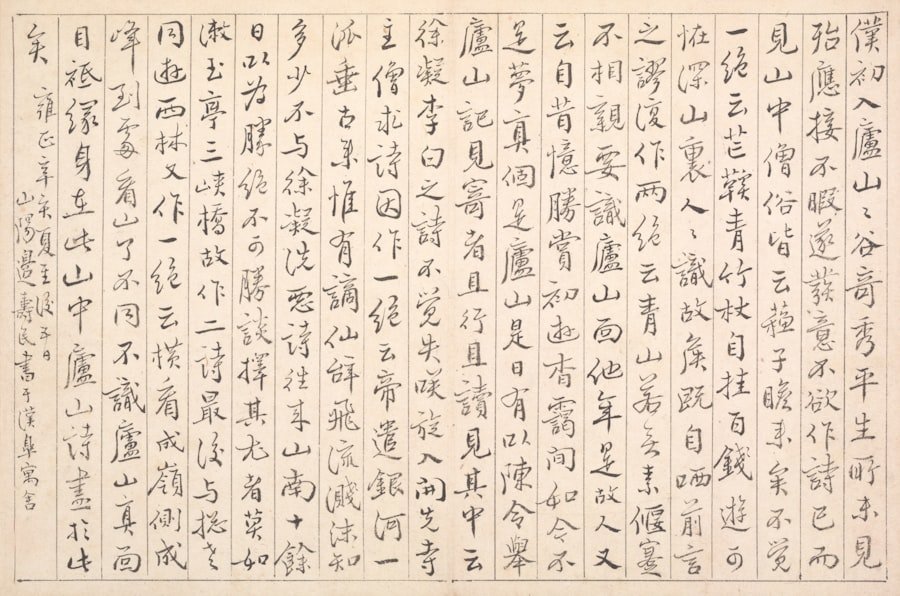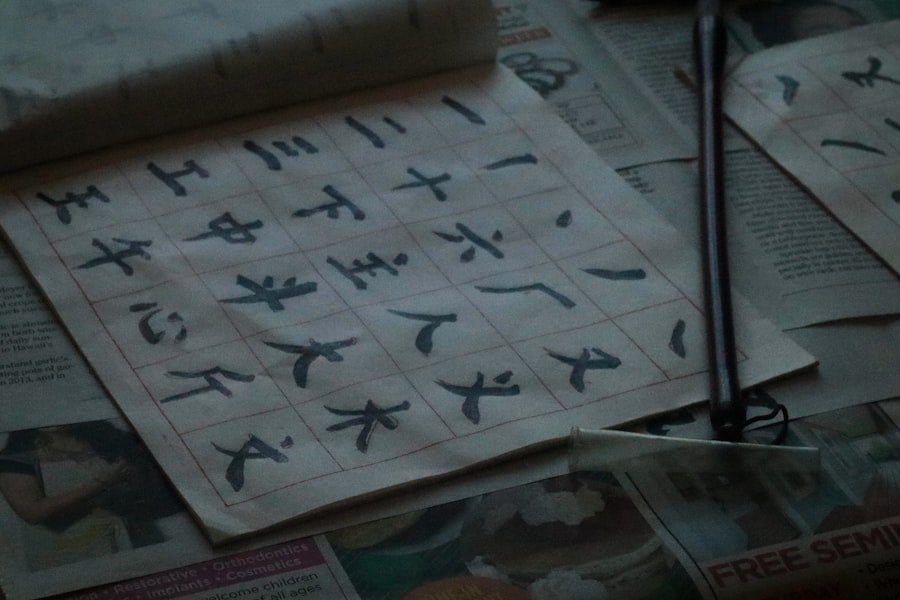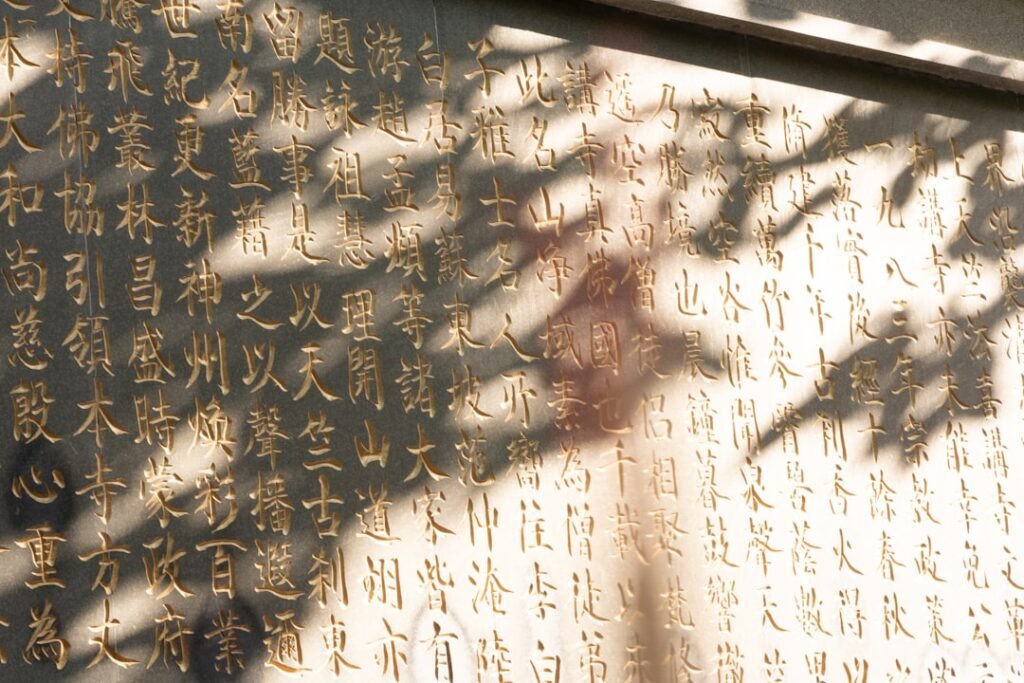Kai Script, known as 楷书 (kǎi shū) in Chinese, is one of the most revered forms of Chinese calligraphy. It is often regarded as the standard script, embodying clarity and precision. The beauty of Kai Script lies not only in its aesthetic appeal but also in its historical significance, as it serves as a bridge between ancient and modern Chinese writing.
This script is characterised by its neatness and uniformity, making it an ideal choice for both beginners and seasoned calligraphers alike. As one delves into the world of Kai Script, they embark on a journey that intertwines art, culture, and history. The allure of Kai Script extends beyond mere letters; it encapsulates the essence of Chinese philosophy and aesthetics.
Each stroke is imbued with meaning, reflecting the calligrapher’s emotions and intentions. As practitioners learn to master this script, they not only develop their technical skills but also cultivate a deeper appreciation for the cultural heritage that it represents. In this article, we will explore the intricacies of Kai Script, from its historical roots to its modern applications, while highlighting the importance of learning this beautiful art form. Master the art of Chinese calligraphy. Enroll now at the LC Chinese School in Oslo.
Table of Contents
ToggleSummary
- Kai Script, also known as 楷书 (kǎi shū), is a traditional Chinese calligraphy style known for its elegance and beauty.
- Understanding the history and significance of Kai Script is essential for appreciating its cultural and artistic value.
- Mastering the basic strokes and structure of Kai Script is the foundation for developing proficiency in this art form.
- Tools and materials such as brushes, ink, and paper are crucial for practicing Kai Script calligraphy.
- Developing a personal style in Kai Script allows for artistic expression while honouring the tradition and beauty of this art form.
Understanding the History and Significance of Kai Script
The origins of Kai Script can be traced back to the Han Dynasty (206 BCE – 220 CE), where it began to emerge as a distinct style of writing. It evolved from earlier scripts such as Seal Script and Clerical Script, gradually gaining popularity due to its legibility and elegance. By the Tang Dynasty (618 – 907 CE), Kai Script had solidified its status as the standard form of writing in China, used in official documents and literature alike.
This historical context is crucial for understanding the significance of Kai Script in Chinese culture. Kai Script is not merely a means of communication; it is a reflection of the philosophical ideals that underpin Chinese society. The emphasis on balance, harmony, and order in Kai Script mirrors the Confucian values that have shaped Chinese thought for centuries.
As such, mastering this script is not just about learning to write; it is about engaging with a rich cultural legacy that continues to influence contemporary life. The historical journey of Kai Script serves as a testament to its enduring relevance and importance in the realm of Chinese calligraphy.
Mastering the Basic Strokes and Structure of Kai Script

To truly appreciate the beauty of Kai Script, one must first master its fundamental strokes. The script comprises several basic strokes, each with its own unique characteristics and techniques. These strokes form the building blocks of all characters written in Kai Script.
Practitioners begin by learning these strokes individually, focusing on their execution and flow. This foundational knowledge is essential for developing proficiency in writing more complex characters. Once the basic strokes are mastered, learners can begin to explore the structure of characters in Kai Script.
Each character is composed of various strokes arranged in a specific order, which contributes to its overall balance and aesthetic appeal. Understanding the structure allows calligraphers to create characters that are not only legible but also visually pleasing. As students practice writing characters, they develop an intuitive sense of how to balance form and function, leading to a more refined calligraphic style.
Tools and Materials for Practicing Kai Script
The tools and materials used in Kai Script calligraphy play a significant role in shaping the final outcome of each piece. Traditional calligraphy requires specific instruments, including brushes, ink, paper, and ink stones. The brush is perhaps the most crucial tool; its flexibility and shape allow for a range of strokes that define the character’s form.
Selecting the right brush is essential for achieving the desired effect in each stroke. In addition to brushes, the choice of paper can greatly influence the quality of one’s work. Rice paper is often preferred for its smooth texture and ability to absorb ink effectively.
However, other types of paper can also be used depending on the desired outcome. Ink stones are used to grind ink sticks into liquid ink, allowing for a rich and deep colour that enhances the visual impact of the calligraphy. By familiarising themselves with these tools and materials, practitioners can elevate their calligraphy practice and create works that resonate with both tradition and personal expression.
Developing a Personal Style in Kai Script Calligraphy
As practitioners become more comfortable with the techniques of Kai Script, they may begin to explore their own personal style within this traditional framework. While mastering the fundamentals is essential, developing a unique voice in calligraphy allows artists to express their individuality and creativity. This process often involves experimenting with different brush techniques, ink densities, and character formations.
Personal style can also be influenced by one’s emotional state or artistic intentions at the time of creation. Some calligraphers may choose to emphasise fluidity and movement in their strokes, while others may focus on precision and symmetry. This exploration not only enriches the artist’s experience but also contributes to the broader landscape of contemporary calligraphy.
By embracing their unique perspectives, practitioners can create works that resonate with both themselves and their audience.
Understanding the Importance of Balance and Proportion in Kai Script

Balance and proportion are fundamental principles in Kai Script calligraphy that significantly impact the overall aesthetic quality of a piece. Each character must be carefully constructed to ensure that it appears harmonious when viewed as part of a larger composition. This involves paying attention to the spacing between strokes as well as the relationship between different characters within a word or phrase.
Achieving balance requires a keen eye and a deep understanding of how each stroke interacts with others. Calligraphers often spend years honing their skills in this area, learning to adjust their techniques based on the specific demands of each character. The pursuit of balance not only enhances the visual appeal of calligraphy but also reflects the philosophical ideals inherent in Chinese culture—an emphasis on harmony and unity that resonates throughout various art forms.
Practicing Patience and Discipline in Learning Kai Script
Learning Kai Script is not an endeavour that yields immediate results; it requires patience and discipline from practitioners. The journey towards mastery can be long and challenging, often filled with moments of frustration as one grapples with complex strokes or struggles to achieve desired levels of precision. However, it is precisely through these challenges that growth occurs.
Regular practice is essential for developing both technical skills and artistic sensibilities. Calligraphers are encouraged to set aside dedicated time for practice, allowing them to refine their techniques gradually over time. This commitment fosters resilience and perseverance—qualities that are invaluable not only in calligraphy but also in other aspects of life.
As practitioners learn to embrace the process rather than fixate solely on outcomes, they cultivate a deeper appreciation for the art form itself.
Exploring the Cultural and Artistic Significance of Kai Script
Kai Script holds profound cultural significance within Chinese society, serving as a symbol of education, refinement, and artistic expression. Historically, calligraphy was regarded as one of the highest forms of art in China, often associated with scholars and literati who valued intellectual pursuits alongside artistic endeavours. The practice of writing in Kai Script was seen as a reflection of one’s character and moral standing.
In contemporary contexts, Kai Script continues to inspire artists across various disciplines—from visual arts to design—demonstrating its versatility as an artistic medium. The script’s elegant lines and balanced forms lend themselves well to modern interpretations, allowing artists to explore new avenues while remaining rooted in tradition. By engaging with Kai Script, individuals not only connect with their cultural heritage but also contribute to its ongoing evolution within contemporary art.
Learning from Master Calligraphers and Their Works in Kai Script
One of the most enriching aspects of studying Kai Script is the opportunity to learn from master calligraphers who have dedicated their lives to this art form. These individuals possess a wealth of knowledge and experience that can greatly benefit aspiring calligraphers. By studying their works—whether through books, exhibitions, or workshops—students gain insights into various techniques, styles, and philosophies that inform their practice.
Master calligraphers often emphasise the importance of understanding tradition while also encouraging innovation within one’s work. They serve as both mentors and sources of inspiration for those seeking to deepen their connection with Kai Script. Engaging with their teachings allows practitioners to appreciate the nuances of this art form while also fostering a sense of community among fellow enthusiasts.
Applying Kai Script in Modern Contexts and Artistic Expressions
In today’s fast-paced world, there is a growing interest in integrating traditional art forms like Kai Script into modern contexts. Artists are increasingly exploring ways to incorporate calligraphy into various mediums—ranging from graphic design to fashion—creating unique fusions that resonate with contemporary audiences. This blending of old and new not only revitalises interest in Kai Script but also showcases its adaptability as an art form.
Moreover, many individuals are discovering the therapeutic benefits associated with practicing calligraphy. The meditative nature of writing allows for mindfulness and self-expression, making it an appealing pursuit for those seeking solace amidst daily stresses. As more people embrace these modern applications of Kai Script, they contribute to its ongoing relevance while honouring its rich history.
Embracing the Beauty and Tradition of Kai Script Calligraphy
In conclusion, Kai Script stands as a testament to the enduring beauty and significance of Chinese calligraphy. Its historical roots provide context for understanding its cultural importance while offering insights into artistic expression across generations. As practitioners embark on their journey towards mastering this elegant script, they engage with a rich tapestry woven from tradition, philosophy, and creativity.
For those interested in delving deeper into this captivating art form, LC Chinese School in Oslo offers specialised courses in Chinese calligraphy that focus on Kai Script among other styles. These courses provide an excellent opportunity for individuals to learn from experienced instructors while connecting with fellow enthusiasts who share a passion for this timeless craft. Embracing the beauty and tradition of Kai Script not only enriches one’s artistic journey but also fosters a deeper appreciation for Chinese culture as a whole—a journey well worth undertaking for anyone captivated by the art of writing.
Master the art of Chinese calligraphy. Enroll now at the LC Chinese School in Oslo.







